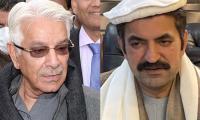Each year towards the end of May we look to the Federal Bureau of Statistics (FBS) to report the gross domestic product (GDP) numbers, which is the official word on the amount of new wealth we create during the year. Policymakers see the GDP as a reliable measure of economic performance and make increasing it the main goal of economic policy.
This year, it will be closely watched to see how far we managed to come out of the economic hole of the previous two years. The rough forecasts of GDP reported last week by international agencies put its growth at about 1.5 percent, which sounds like an improvement, but only because its growth was even less in the previous two years. In reality, in the past three years, we became poorer in terms of GDP per head since we add about two percent more to our population each year.
Nevertheless, it makes little sense to look at GDP in isolation – because it is not the same thing as well-being. So, when policymakers look to it as a measure of performance, they overlook its distributional aspects. For instance, during 2013-17 – while GDP grew briskly by five percent and above each year – the wealth created was way out of step with gloomier data on illiteracy, disease, mal-nutrition, stagnating wages, which means that the lives of millions of poor people were no better. The message here is that misusing, misrepresenting GDP numbers and not qualifying them only cloud our judgement and deceive us of the truth.
So, what is wrong with our GDP? A number of things. The key issue is that because of rising income inequality a higher GDP very likely indicates more wealth for a few people at the very top. Being an aggregate number, GDP only indicates what is happening overall, which has little relevance to the ordinary people.
The following example makes this clear: if a billionaire steps into a Langar Khaana the average wealth of its patrons would shoot up by tens of thousands of rupees but none of them gets any richer. And, the patrons’ average wealth falls back to a tiny amount as soon as the billionaire steps out of it.
This clarifies why ordinary people disregard what happens to GDP, because their daily experience – for instance, stagnating wages and falling purchasing power – is far from the ‘average’ reality the numbers claim to describe.
The question then is: since the ordinary people are not faring well, then who is benefitting from GDP growth? To get an idea who its beneficiaries are we look at the annual reports of nine private companies listed on the stock exchange, including textile mills, fertilizer, cement companies and banks.
It turns out, during the last two years, these companies made a whopping after-tax profit of Rs296 billion, of which Rs189 billion is the profit of only five banks. Mind you, these are just nine of 540 similarly large companies listed on the stock exchange. But even a slight look at corporate profits brings us closer to the answer, which is that a large chunk of national wealth goes to a handful of rich owners of companies and banks.
Rs296 billion is a big amount, as much as three quarters of the federal development package announced last week to uplift all of Sindh. Sizing it up with our welfare programmes reveals a pitiful reality: For instance, the monthly cost of the Ehsaas Kafaalat programme, claiming to give a meager Rs2,000 per month each to seven million poor people, sums up to just Rs14 billion. Even after adding to this the future cost of the Nashonuma programme, assuming it may help a million children, the cost sums to only Rs14.6 billion. It means annually the Ehsaas Kafaalat and Nashonuma programmes together give millions of poor people about as much money as goes in the pockets of a handful of rich people owning nine companies.
This speaks volumes about how pitifully small welfare programmes and development packages are. In other words, the discontent of millions of poor people is much starker than most people seem to realize or GDP numbers reveal.
The message here is that GDP numbers don’t tell what is really going on in the country. And, it is important to track how GDP growth is allocated among different income groups. In technical language, such numbers are called distributional national accounts. They need to be prepared so that policymakers may be compelled to produce broad-based economic growth, and to spend far more on schools, health facilities, job creation, welfare programmes. Unless, that is, they don’t want to know what such accounts might reveal, and so turn a blind eye to what is not measured.
Tracking growth and changing how GDP numbers are reported is the task of the FBS. But the FBS does not even do its current job well, which brings us to the other key issue in our GDP story – the integrity of its estimates. By integrity of GDP one means the weak, under-funded, under-manned, institutional setup of the FBS, which cripple its capacity to produce good official numbers. Their integrity took a plunge two years ago when the FBS was put under the control of the planning ministry, a major user of FBS numbers, apparently to save money. This defies the Statistics Act 2011, which guarantees the FBS’ independence, and it flouts the UN’s Fundamental Principles of Official Statistics, which requires that the official statistics agency should be impartial to government influence.
The FBS has to be set right. And how we measure economic success has to be fixed so that we may see the policies that benefit the rich as what they are. The government’s job is to strengthen the FBS so that it may produce meaningful national accounts numbers.
The writer is a freelance contributor.
Email: khwaja.sarmad@gmail.com
India uses Afghanistan as a backstage area to carry out terrorist attacks against Pakistan
Another report by the Pakistan Institute of Peace Studies states that 78 per cent of attacks have been carried out by...
Pakistan stands at the forefront of this crisis, generating a staggering 3.3 million tonnes of plastic waste annually
Today, a total of 11,000 children are attending Daanish schools in Punjab
The emotional instability of parents inculcates a range of psychological issues in children
The current way of dealing with the environment and climate change is no longer adequate







